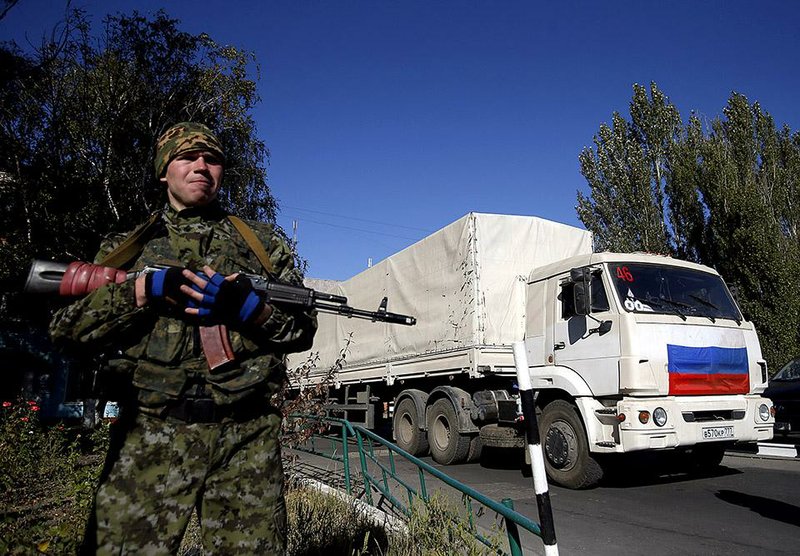MINSK, Belarus -- Sporadic artillery fire hit parts of eastern Ukraine on Saturday, hours after negotiators agreed to create a buffer zone between government troops and pro-Russia militants by halting their advances, pulling back heavy weapons and withdrawing foreign fighters.
Despite positive developments coming out of talks in the Belarusian capital of Minsk and a cease-fire that has been in place since Sept. 5, the fighting between the two sides was still deadly.
In Donetsk, the largest rebel-held city, strong explosions could be heard from a munitions factory that a local official said was hit by an artillery shell. It was unclear which side fired it. Explosions were heard in three areas of the city in the afternoon, the city council said.
The Interior Ministry said rebels had opened fire on the village of Stakhanovets in the Luhansk region, but it had no immediate information on casualties.
Ukrainian national security council spokesman Volodymyr Polyoviy said Saturday that about 20 rebels and one soldier had been killed in clashes but did not specify if those took place after the negotiators agreed on the buffer zone about 4 a.m.
The deal reached by representatives of Ukraine, Russia, the Moscow-backed rebels, and the Organization for Security and Cooperation in Europe marks an effort to add substance to a cease-fire agreement that has been frequently broken.
The signed deal states the two sides should stay where they were Friday and make no attempt to advance.
Leonid Kuchma, a former Ukrainian president who represented the Kiev government at the talks, said the memorandum will be implemented within a day.
Under the deal, each party must pull back artillery of 100 millimeters or larger at least 9 miles, setting up a buffer zone that would be 19 miles wide. The longer-range artillery systems are to be pulled even farther back to make sure the parties can't reach one another.
The deal also specifically bans flights by combat aircraft over the area of conflict and setting up new minefields.
"It should offer the population a chance to feel secure," said Igor Plotnitskyi, the leader of rebels in the Luhansk region.
The rebels are located near the cities of Donetsk and Luhansk in eastern Ukraine and the port city of Mariupol on the Sea of Azov coast, but their positions elsewhere are not clear. Ukrainian government forces are at the airport in Donetsk but the location of their lines outside that city is also unclear.
The memorandum also envisages the withdrawal of "all foreign armed units and weapons, as well as militants and mercenaries" -- a diplomatic reference to Russians fighting alongside the rebels.
Ukraine and the West have accused Russia of fueling the insurgency in eastern Ukraine with weapons and soldiers. Moscow has denied that, saying that Russians who joined the mutiny did so as private citizens.
Heidi Tagliavini, the security organization's envoy in the talks, said the group's monitors will be deployed to the buffer zone to monitor the cease-fire.
In the Lithuanian capital of Vilnius, NATO's top general, U.S. Air Force Gen. Philip Breedlove, said the September deal is a "cease-fire in name only." He said the violence, including the number of artillery rounds fired in the past few days, is as high as prior to the cease-fire.
Breedlove said he hopes the agreement announced Saturday to create a buffer zone between Ukrainian government troops and the pro-Russia militants will succeed in stabilizing the situation.
Violence levels in Ukraine, including the number of artillery rounds fired in the past few days, are as high as prior to the cease-fire, Breedlove said.
"So the cease-fire is still there in name, but what is happening on the ground is quite a different story," he said.
He also said it is clear that the number of Russian troops in Ukraine has declined significantly over the past week or so, with some returning to the Russian side of the border -- "which is good, except that they haven't returned home and are still available to bring their military force to bear on Ukraine, should it be desired" by Russian government leaders.
The insurgency in the mostly Russian-speaking Donetsk and Luhansk regions flared up after the ouster of Ukraine's former pro-Russia president in February and Russia's annexation of Crimea the next month. Five months of fighting has killed at least 3,000 people and devastated the regions that formed Ukraine's industrial heartland.
As part of a compromise to end the hostilities, the Ukrainian parliament this week passed a law giving a broad autonomy to the areas controlled by the rebels, including the power to hold local elections and form their own police force.
Alexander Zakharchenko, the leader of rebels in Donetsk, said Ukraine and the rebels have conflicting interpretations of the law and the talks should continue.
Information for this article was contributed by Laura Mills, Vladimir Isachenkov, Jim Heintz and Robert Burns of The Associated Press.
A Section on 09/21/2014


